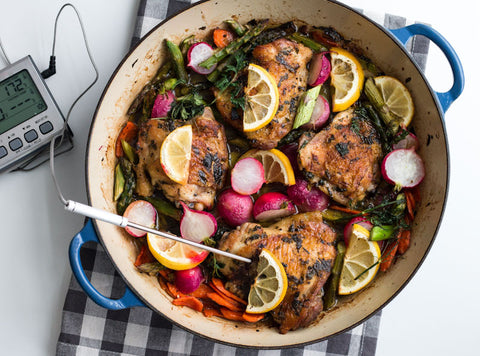
Grass-fed and pastured animals lead more natural and active lives, resulting in leaner cuts of meat. Compared to their grain-fed counterparts, grass-fed and pastured meat tends to cook faster because of lower fat content and different muscle structures. If cooked using traditional time-based methods, these lean cuts may end up overcooked and less palatable. This is especially true for some traditionally quickly cooked cuts, such as filet mignon or other lean steaks that must be seared, then allowed to rest.
To preserve the tenderness and natural juiciness of grass-fed and pastured meat, temperature is a more reliable indicator of doneness than cooking time. Using a meat thermometer, you can monitor the internal temperature of the meat to ensure it reaches the desired level of doneness without risking overcooking. This method not only prevents dryness but also preserves the full flavor profile of the meat.
The ideal cooking temperature for grass-fed and pastured meat varies depending on the cut and personal preference. Here are some general guidelines:
- Rare: 125°F to 130°F (51°C to 54°C)
- Medium-Rare: 135°F to 140°F (57°C to 60°C)
- Medium: 145°F to 160°F (63°C to 71°C)
- Well-Done: 160°F and above (71°C and above)
Remember that the internal temperature of the meat will continue to rise even after it is removed from the heat source, so consider this carryover cooking while determining your desired doneness.
It is important to note that while some cuts, such as rack of lamb, should be treated delicately and allowed to cook to a perfect internal temperature for medium-rare by searing and roasting, other cuts, such as Boston Butt, ribs, or Chuck Roast should reach a high internal temperature in order to achieve the perfect fall-apart, fork-tender texture. Due to the lower fat content in grass-fed and pastured meat, traditional high-heat cooking methods may not always be as effective. Instead, depending on the cut, consider using slower cooking techniques, such as roasting, braising, or sous vide, to maintain tenderness and moisture throughout the cooking process.
After reaching the desired internal temperature, remove the meat from the heat source and allow it to rest under an aluminum foil tent for a few minutes-or up to an hour, depending on your recipe, before slicing or serving. This resting period lets the meat's juices redistribute, resulting in a more succulent and flavorful dish.
Cooking grass-fed or pastured meat requires a thoughtful and precise approach, with temperature being the most important factor. By using a meat thermometer and adjusting your cooking techniques, you can ensure that your grass-fed and pastured meat turns out perfectly tender, flavorful, and juicy every time. Embrace the beauty of our premium cuts by allowing temperature, not time, to guide you on your culinary journey.